Management Accounting Report: Agmet Chemical Manufacturing
VerifiedAdded on 2020/10/22
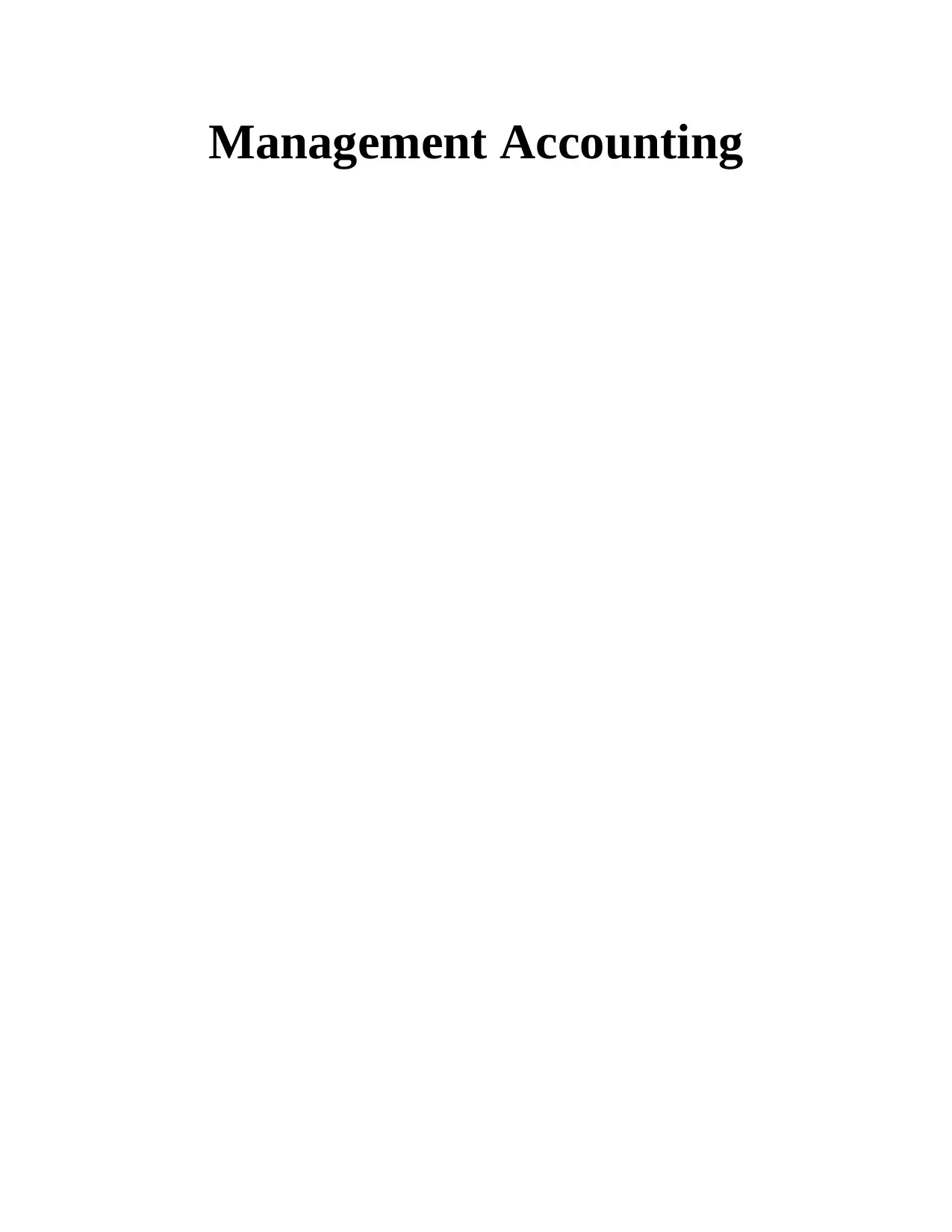
Paraphrase This Document
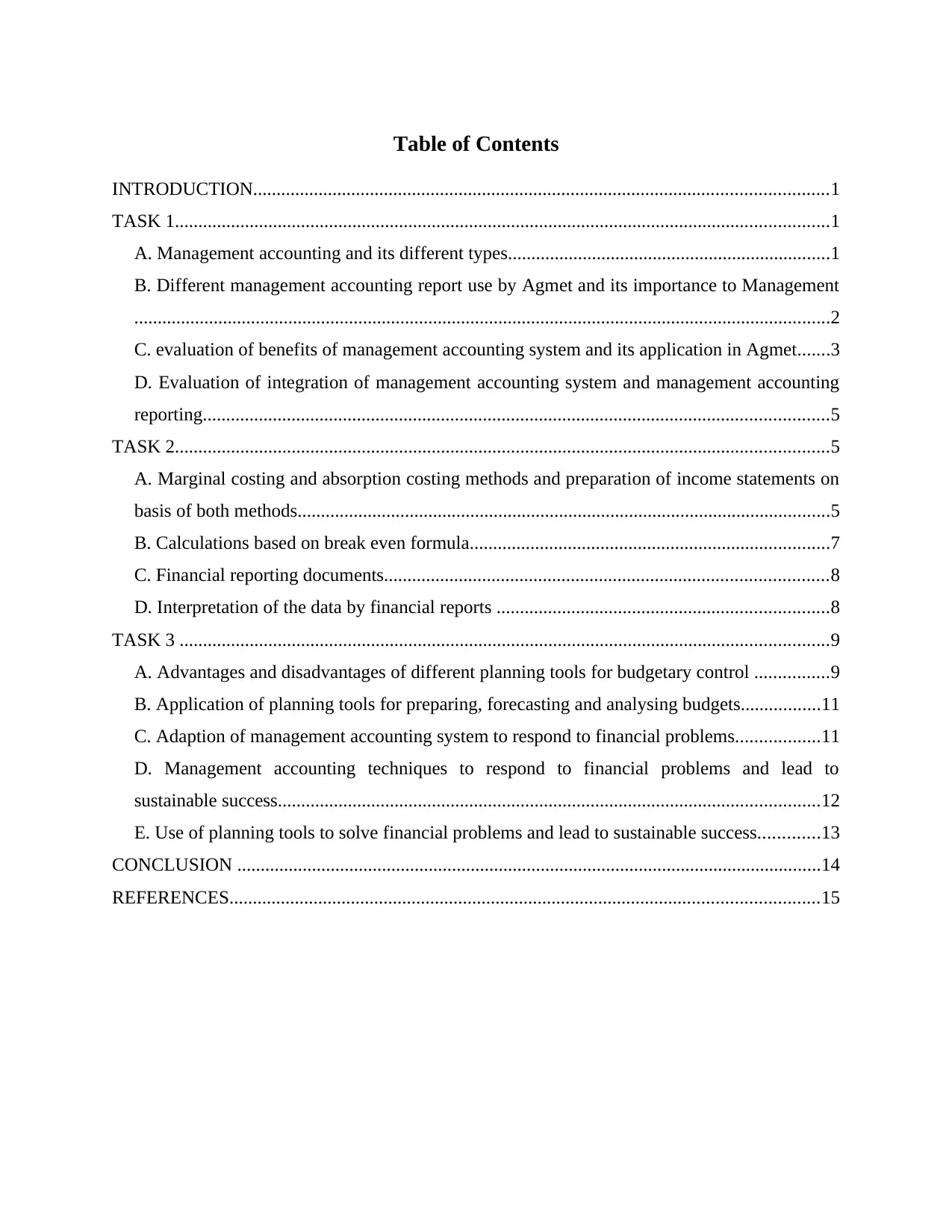
INTRODUCTION...........................................................................................................................1
TASK 1............................................................................................................................................1
A. Management accounting and its different types.....................................................................1
B. Different management accounting report use by Agmet and its importance to Management
.....................................................................................................................................................2
C. evaluation of benefits of management accounting system and its application in Agmet.......3
D. Evaluation of integration of management accounting system and management accounting
reporting......................................................................................................................................5
TASK 2............................................................................................................................................5
A. Marginal costing and absorption costing methods and preparation of income statements on
basis of both methods..................................................................................................................5
B. Calculations based on break even formula.............................................................................7
C. Financial reporting documents...............................................................................................8
D. Interpretation of the data by financial reports .......................................................................8
TASK 3 ...........................................................................................................................................9
A. Advantages and disadvantages of different planning tools for budgetary control ................9
B. Application of planning tools for preparing, forecasting and analysing budgets.................11
C. Adaption of management accounting system to respond to financial problems..................11
D. Management accounting techniques to respond to financial problems and lead to
sustainable success....................................................................................................................12
E. Use of planning tools to solve financial problems and lead to sustainable success.............13
CONCLUSION .............................................................................................................................14
REFERENCES..............................................................................................................................15

Management accounting is an area related with activities of decision-making, devising
planning, performance management system, providing financial reporting expertise and planning
formulation implementation of organisational strategy and its controlling. It is a planning and
decision support system of an organisation. Management accounting system takes all financial
and operational information and present reports which assists in decision-making process.
The present report is about business Agmet, which is a chemical product-manufacturing
unit. The report presents Agmet with different management accounting systems and report and
states all their benefits. An Application of various planning tools their advantages and
disadvantages to the firm. Are also explained.
TASK 1
A. Management accounting and its different types
Management Accounting
Management Accounting is a combination of financial and statistical information and
preparation of management reports on the basis of available information. These reports guide
management of a business in decision-making process (Maas, Schaltegger and Crutzen, 2016.
Management accounting takes into consideration the entire activities of an organisation, which
are accounting, financial, operational and statistical activities take data and relevant information
from these activities and make day-to-day business decisions.
The reports that are presented under management accounting system provides details and
information related to cash and cash equivalents available with the firm, revenues generated from
sales, status of accounts payables and receivables, raw material, inventories and debtors and
creditors of the firm.
Different types of management accounting systems are:
Cost Accounting System: this system of management accounting deals with
determination of cost related to production of units of goods in a firm. The cost and sales
revenue are evaluated to determine profits. This system classifies information in manner required
1
⊘ This is a preview!⊘
Do you want full access?
Subscribe today to unlock all pages.

Trusted by 1+ million students worldwide
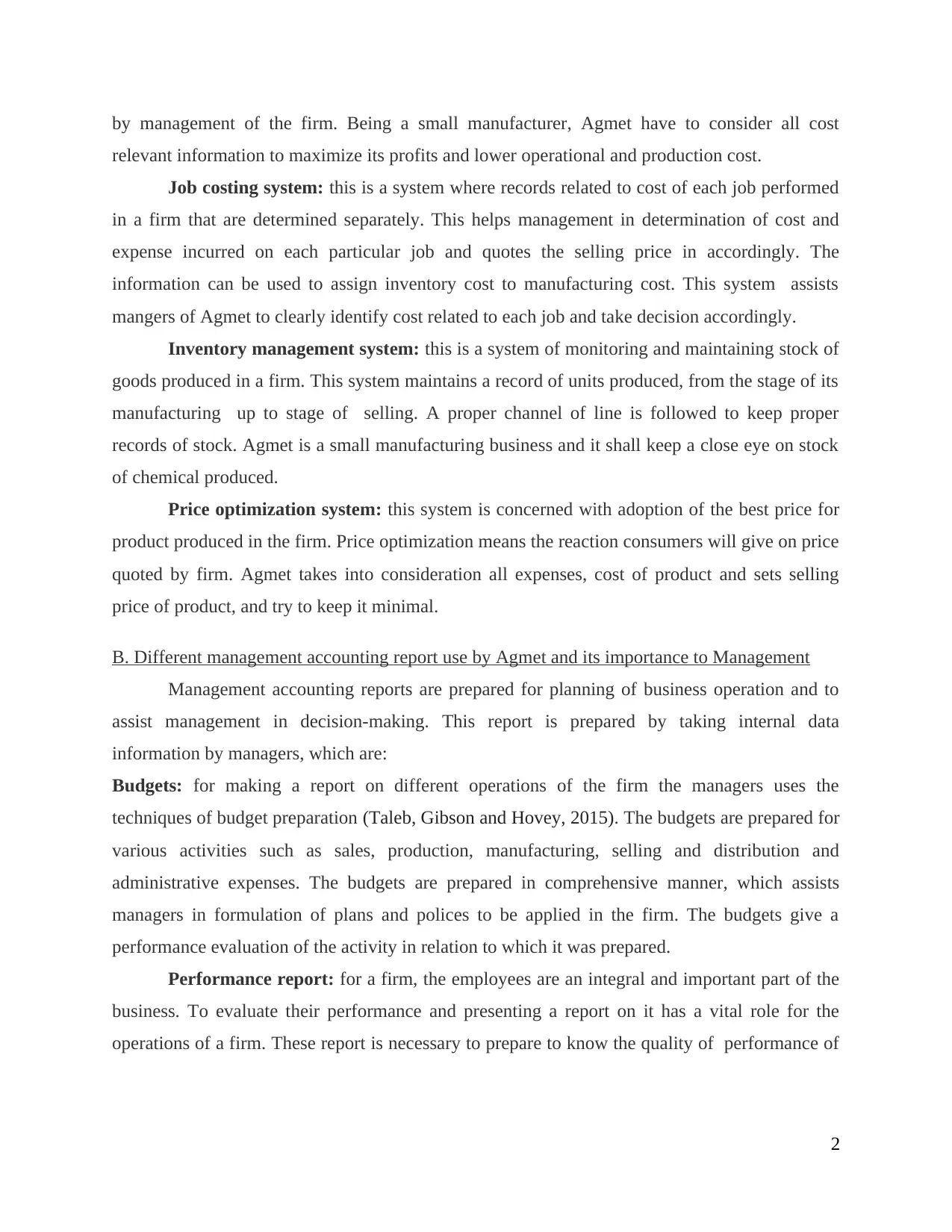
relevant information to maximize its profits and lower operational and production cost.
Job costing system: this is a system where records related to cost of each job performed
in a firm that are determined separately. This helps management in determination of cost and
expense incurred on each particular job and quotes the selling price in accordingly. The
information can be used to assign inventory cost to manufacturing cost. This system assists
mangers of Agmet to clearly identify cost related to each job and take decision accordingly.
Inventory management system: this is a system of monitoring and maintaining stock of
goods produced in a firm. This system maintains a record of units produced, from the stage of its
manufacturing up to stage of selling. A proper channel of line is followed to keep proper
records of stock. Agmet is a small manufacturing business and it shall keep a close eye on stock
of chemical produced.
Price optimization system: this system is concerned with adoption of the best price for
product produced in the firm. Price optimization means the reaction consumers will give on price
quoted by firm. Agmet takes into consideration all expenses, cost of product and sets selling
price of product, and try to keep it minimal.
B. Different management accounting report use by Agmet and its importance to Management
Management accounting reports are prepared for planning of business operation and to
assist management in decision-making. This report is prepared by taking internal data
information by managers, which are:
Budgets: for making a report on different operations of the firm the managers uses the
techniques of budget preparation (Taleb, Gibson and Hovey, 2015). The budgets are prepared for
various activities such as sales, production, manufacturing, selling and distribution and
administrative expenses. The budgets are prepared in comprehensive manner, which assists
managers in formulation of plans and polices to be applied in the firm. The budgets give a
performance evaluation of the activity in relation to which it was prepared.
Performance report: for a firm, the employees are an integral and important part of the
business. To evaluate their performance and presenting a report on it has a vital role for the
operations of a firm. These report is necessary to prepare to know the quality of performance of
2
Paraphrase This Document

managers take corrective measures for better performance of employees.
Cost report: in a business activity the most important thing is cost, to carry on any
activity, business have to spend first then only it can get returns. To manage the cost is critical
and of key importance. The cost incurred can be calculated by using different costing methods
such as job costing, marginal and absorption costing, standard costing.
Project report: these reports are prepared to evaluate the status of ongoing or finished
projects. In these reports, the performance is evaluated in relation to the use of funds allocated to
them and the level of progress and success of such projects (Fullerton, Kennedy and Widener,
2014). These reports present-detailed information on projects. The report also states further
requisition of resources or material for completion of ongoing projects and measures to be taken
for making a project successful.
Activity report: The report is prepared in relation to activities performed in day-to-day
operation of business. This gives a close eye on actual performance of each activity on a daily
basis.
C. Evaluation of benefits of management accounting system and its application in Agmet
Benefits of Cost accounting system:
a tool for measuring and improving efficiency
Throws a light on profitable and non profitable activities
Firm is able to fix the price of its product
Provide guidance for reduction in product price
Provide complete information for proper planning
Information related to stock and various materials are constantly available.
Guides in making decision regarding increase and decrease in production of a particular
product
Cost accounting system assists and guides Agmet in process of decision making in
relation to expansion of production units, cost control, setting up profit margin it needs to earn.
The system also gives an insight in cost bifurcation and relates each part of cost incurred-to
relevant activity.
Benefits of Job costing system:
3
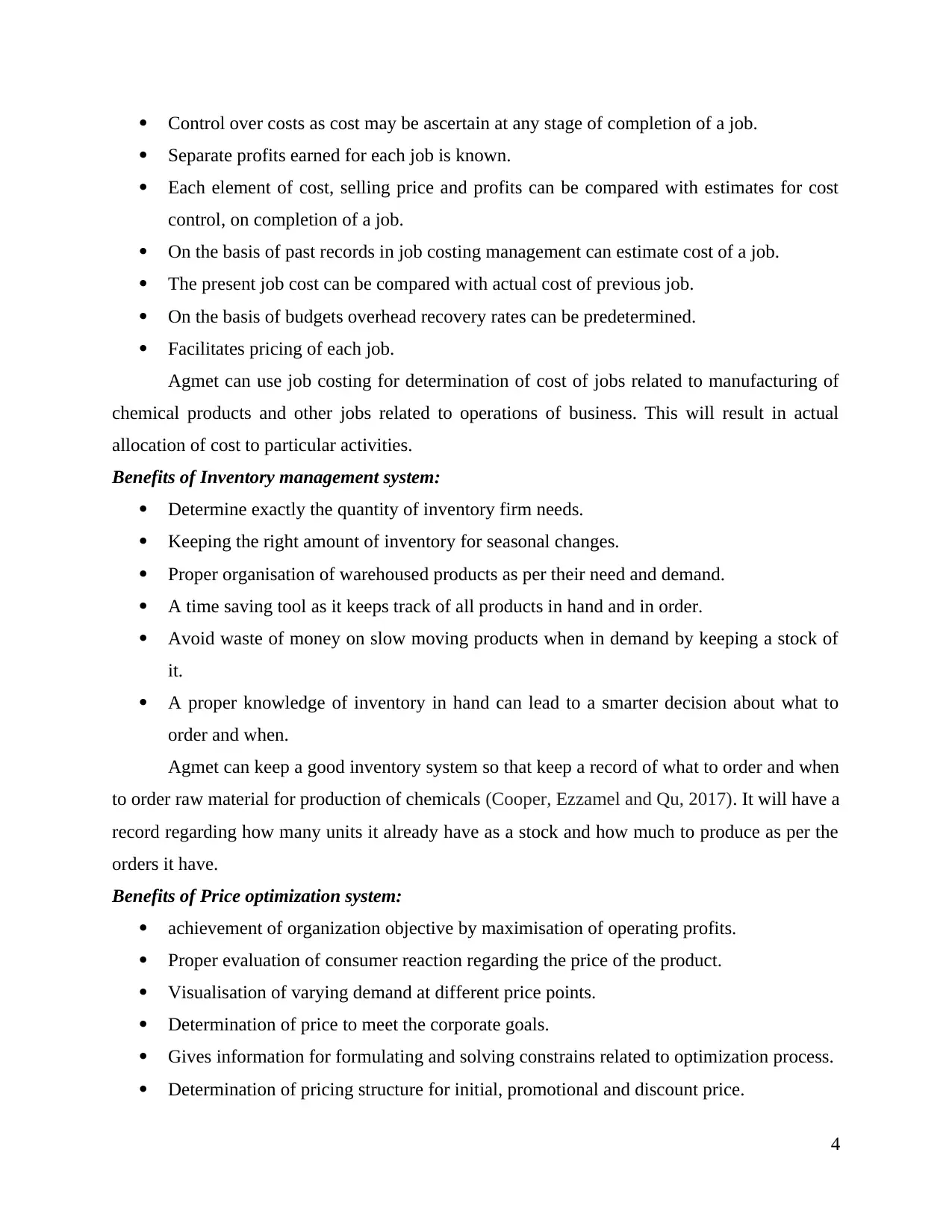
Separate profits earned for each job is known.
Each element of cost, selling price and profits can be compared with estimates for cost
control, on completion of a job.
On the basis of past records in job costing management can estimate cost of a job.
The present job cost can be compared with actual cost of previous job.
On the basis of budgets overhead recovery rates can be predetermined.
Facilitates pricing of each job.
Agmet can use job costing for determination of cost of jobs related to manufacturing of
chemical products and other jobs related to operations of business. This will result in actual
allocation of cost to particular activities.
Benefits of Inventory management system:
Determine exactly the quantity of inventory firm needs.
Keeping the right amount of inventory for seasonal changes.
Proper organisation of warehoused products as per their need and demand.
A time saving tool as it keeps track of all products in hand and in order.
Avoid waste of money on slow moving products when in demand by keeping a stock of
it.
A proper knowledge of inventory in hand can lead to a smarter decision about what to
order and when.
Agmet can keep a good inventory system so that keep a record of what to order and when
to order raw material for production of chemicals (Cooper, Ezzamel and Qu, 2017). It will have a
record regarding how many units it already have as a stock and how much to produce as per the
orders it have.
Benefits of Price optimization system:
achievement of organization objective by maximisation of operating profits.
Proper evaluation of consumer reaction regarding the price of the product.
Visualisation of varying demand at different price points.
Determination of price to meet the corporate goals.
Gives information for formulating and solving constrains related to optimization process.
Determination of pricing structure for initial, promotional and discount price.
4
⊘ This is a preview!⊘
Do you want full access?
Subscribe today to unlock all pages.

Trusted by 1+ million students worldwide
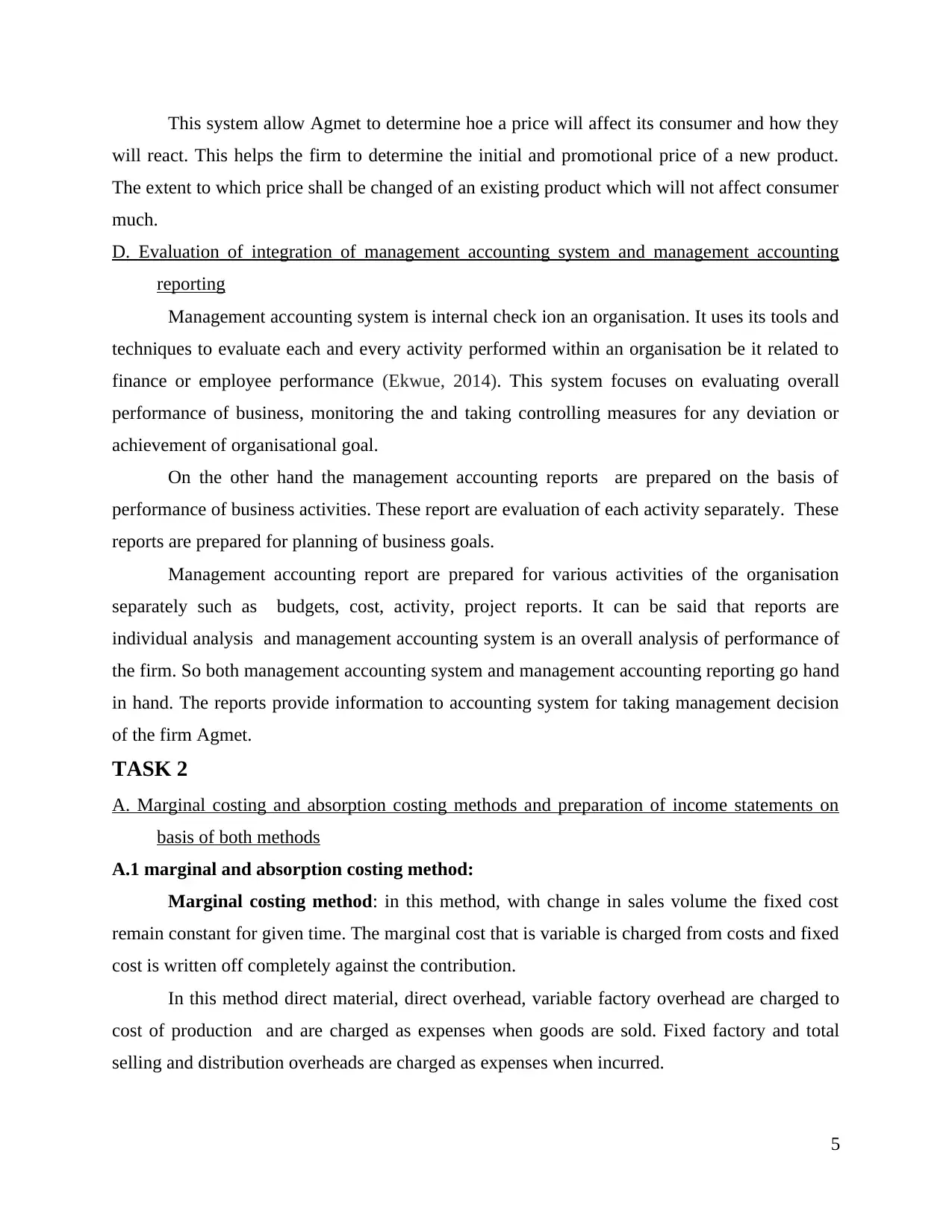
will react. This helps the firm to determine the initial and promotional price of a new product.
The extent to which price shall be changed of an existing product which will not affect consumer
much.
D. Evaluation of integration of management accounting system and management accounting
reporting
Management accounting system is internal check ion an organisation. It uses its tools and
techniques to evaluate each and every activity performed within an organisation be it related to
finance or employee performance (Ekwue, 2014). This system focuses on evaluating overall
performance of business, monitoring the and taking controlling measures for any deviation or
achievement of organisational goal.
On the other hand the management accounting reports are prepared on the basis of
performance of business activities. These report are evaluation of each activity separately. These
reports are prepared for planning of business goals.
Management accounting report are prepared for various activities of the organisation
separately such as budgets, cost, activity, project reports. It can be said that reports are
individual analysis and management accounting system is an overall analysis of performance of
the firm. So both management accounting system and management accounting reporting go hand
in hand. The reports provide information to accounting system for taking management decision
of the firm Agmet.
TASK 2
A. Marginal costing and absorption costing methods and preparation of income statements on
basis of both methods
A.1 marginal and absorption costing method:
Marginal costing method: in this method, with change in sales volume the fixed cost
remain constant for given time. The marginal cost that is variable is charged from costs and fixed
cost is written off completely against the contribution.
In this method direct material, direct overhead, variable factory overhead are charged to
cost of production and are charged as expenses when goods are sold. Fixed factory and total
selling and distribution overheads are charged as expenses when incurred.
5
Paraphrase This Document
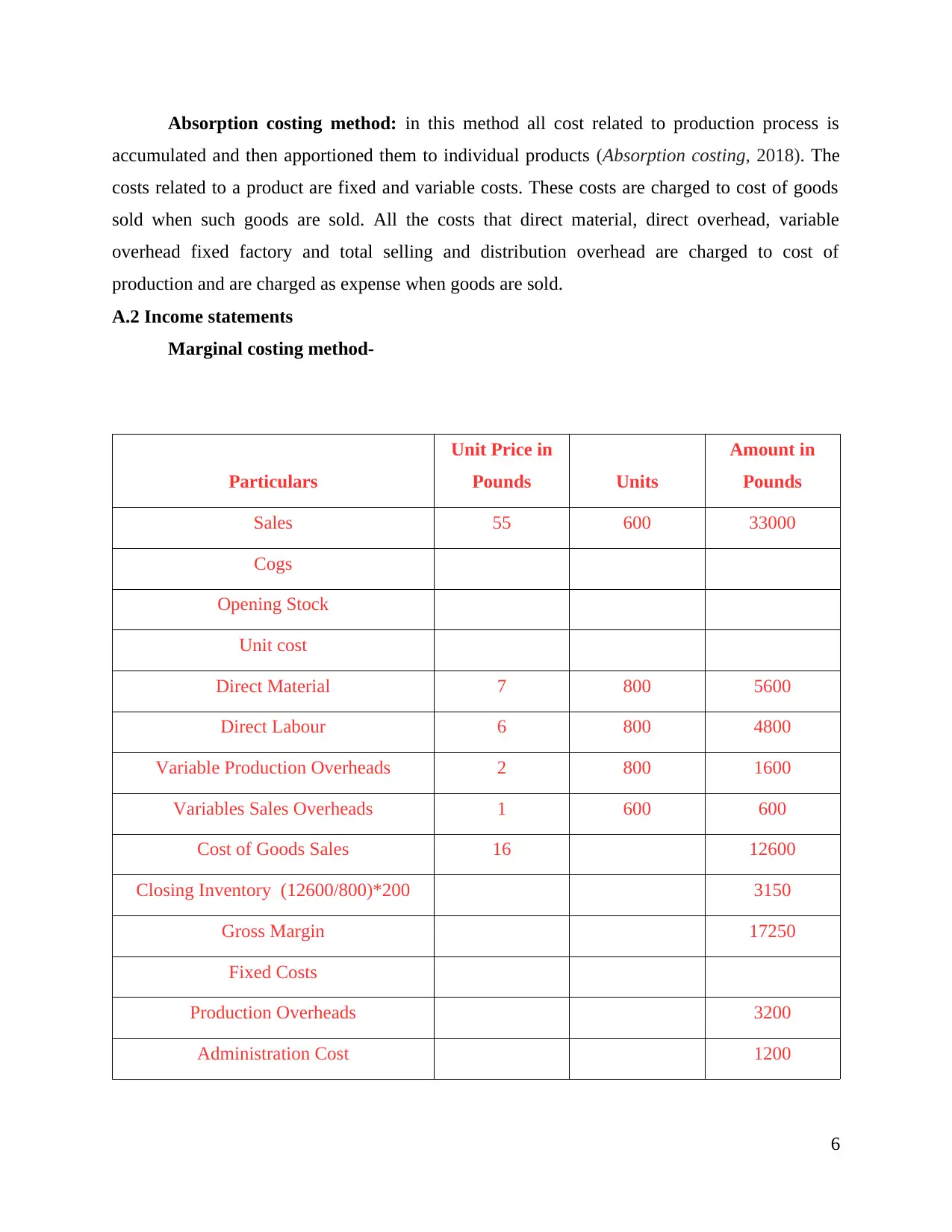
accumulated and then apportioned them to individual products (Absorption costing, 2018). The
costs related to a product are fixed and variable costs. These costs are charged to cost of goods
sold when such goods are sold. All the costs that direct material, direct overhead, variable
overhead fixed factory and total selling and distribution overhead are charged to cost of
production and are charged as expense when goods are sold.
A.2 Income statements
Marginal costing method-
Particulars
Unit Price in
Pounds Units
Amount in
Pounds
Sales 55 600 33000
Cogs
Opening Stock
Unit cost
Direct Material 7 800 5600
Direct Labour 6 800 4800
Variable Production Overheads 2 800 1600
Variables Sales Overheads 1 600 600
Cost of Goods Sales 16 12600
Closing Inventory (12600/800)*200 3150
Gross Margin 17250
Fixed Costs
Production Overheads 3200
Administration Cost 1200
6
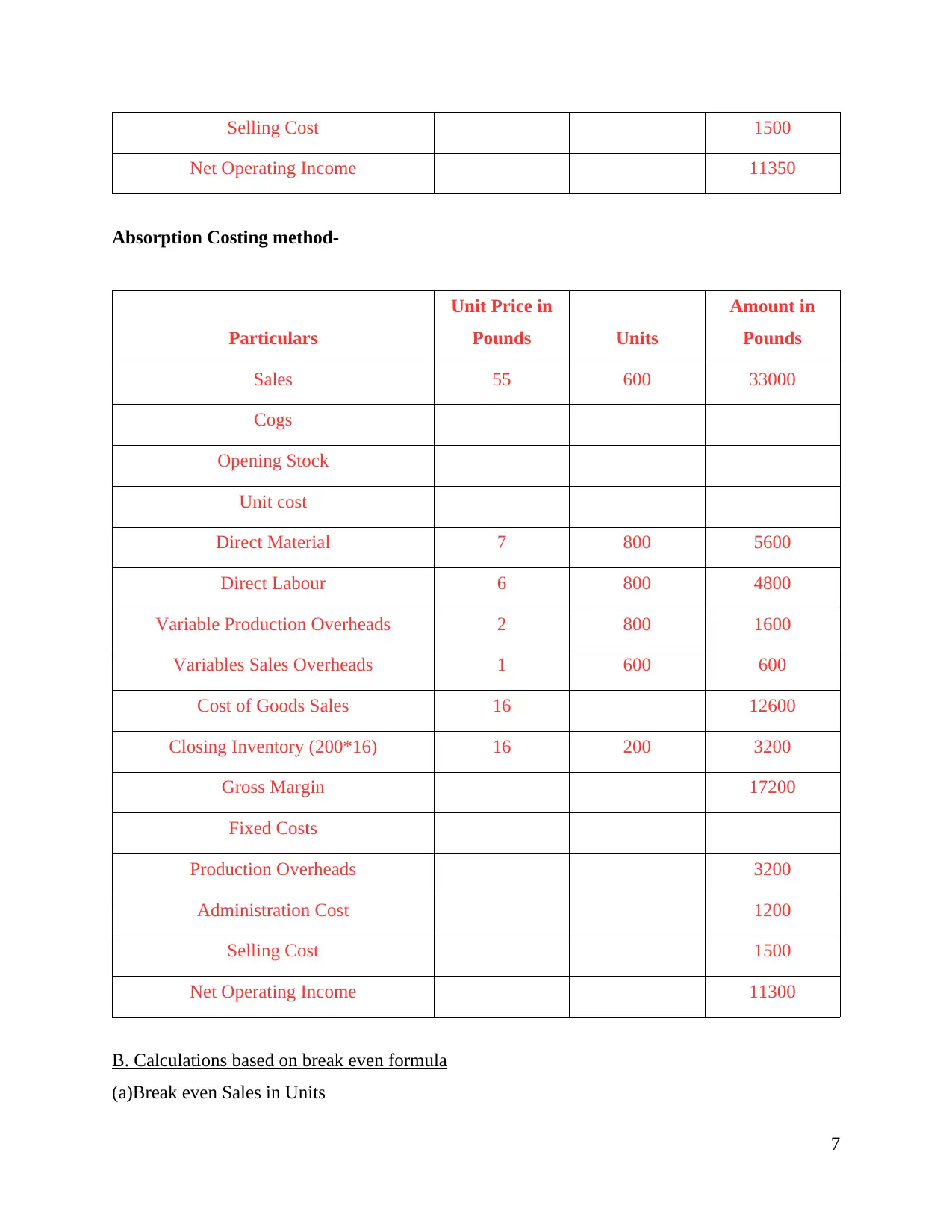
Net Operating Income 11350
Absorption Costing method-
Particulars
Unit Price in
Pounds Units
Amount in
Pounds
Sales 55 600 33000
Cogs
Opening Stock
Unit cost
Direct Material 7 800 5600
Direct Labour 6 800 4800
Variable Production Overheads 2 800 1600
Variables Sales Overheads 1 600 600
Cost of Goods Sales 16 12600
Closing Inventory (200*16) 16 200 3200
Gross Margin 17200
Fixed Costs
Production Overheads 3200
Administration Cost 1200
Selling Cost 1500
Net Operating Income 11300
B. Calculations based on break even formula
(a)Break even Sales in Units
7
⊘ This is a preview!⊘
Do you want full access?
Subscribe today to unlock all pages.

Trusted by 1+ million students worldwide
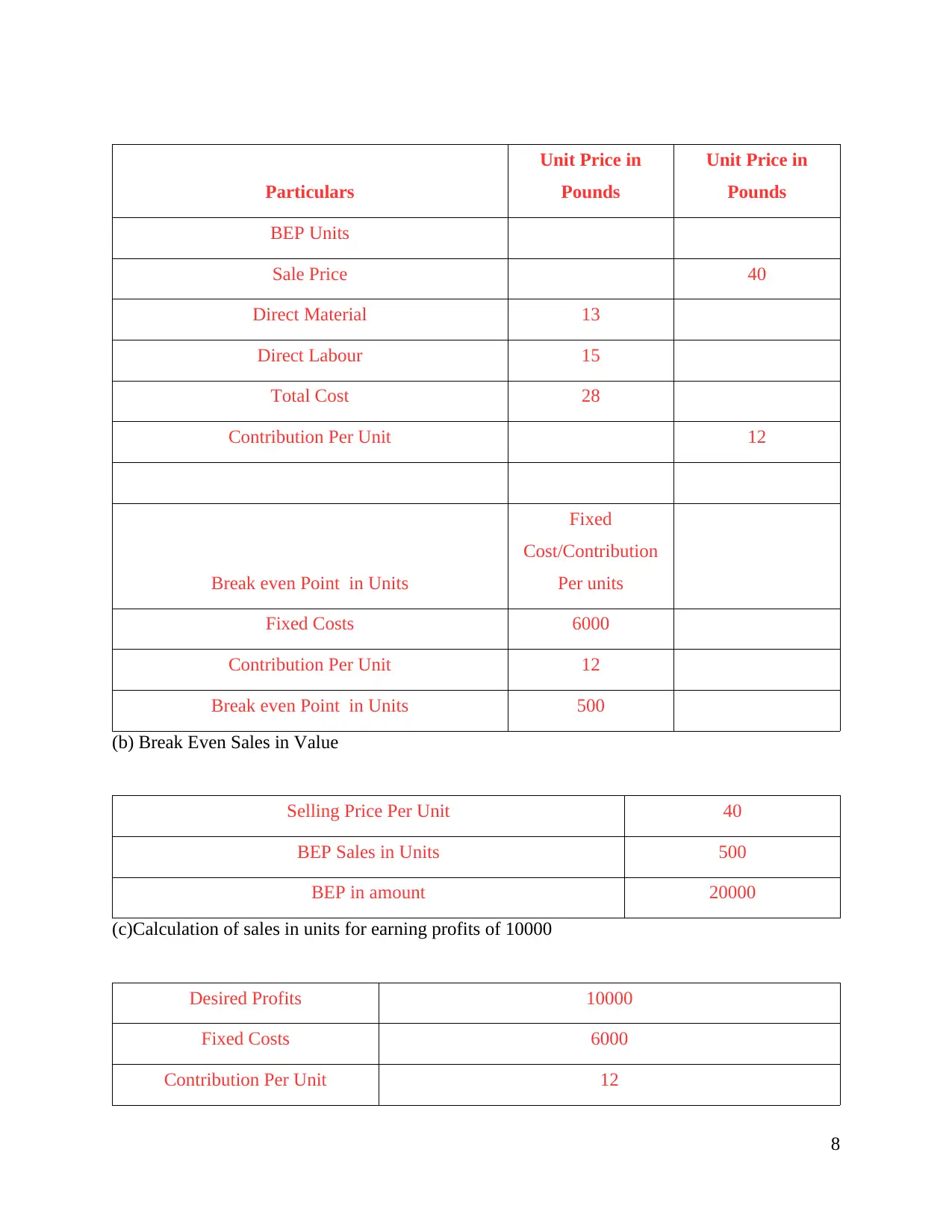
Unit Price in
Pounds
Unit Price in
Pounds
BEP Units
Sale Price 40
Direct Material 13
Direct Labour 15
Total Cost 28
Contribution Per Unit 12
Break even Point in Units
Fixed
Cost/Contribution
Per units
Fixed Costs 6000
Contribution Per Unit 12
Break even Point in Units 500
(b) Break Even Sales in Value
Selling Price Per Unit 40
BEP Sales in Units 500
BEP in amount 20000
(c)Calculation of sales in units for earning profits of 10000
Desired Profits 10000
Fixed Costs 6000
Contribution Per Unit 12
8
Paraphrase This Document
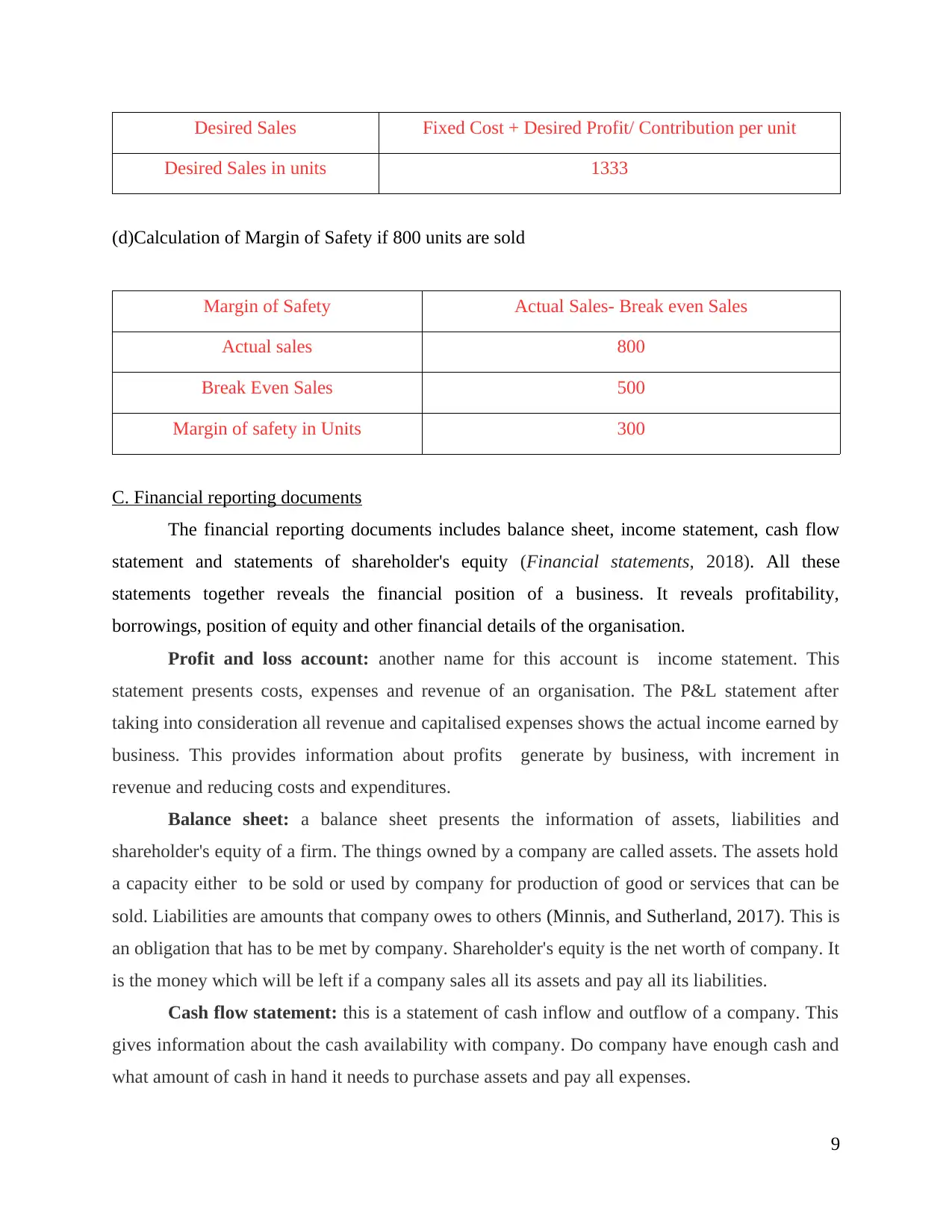
Desired Sales in units 1333
(d)Calculation of Margin of Safety if 800 units are sold
Margin of Safety Actual Sales- Break even Sales
Actual sales 800
Break Even Sales 500
Margin of safety in Units 300
C. Financial reporting documents
The financial reporting documents includes balance sheet, income statement, cash flow
statement and statements of shareholder's equity (Financial statements, 2018). All these
statements together reveals the financial position of a business. It reveals profitability,
borrowings, position of equity and other financial details of the organisation.
Profit and loss account: another name for this account is income statement. This
statement presents costs, expenses and revenue of an organisation. The P&L statement after
taking into consideration all revenue and capitalised expenses shows the actual income earned by
business. This provides information about profits generate by business, with increment in
revenue and reducing costs and expenditures.
Balance sheet: a balance sheet presents the information of assets, liabilities and
shareholder's equity of a firm. The things owned by a company are called assets. The assets hold
a capacity either to be sold or used by company for production of good or services that can be
sold. Liabilities are amounts that company owes to others (Minnis, and Sutherland, 2017). This is
an obligation that has to be met by company. Shareholder's equity is the net worth of company. It
is the money which will be left if a company sales all its assets and pay all its liabilities.
Cash flow statement: this is a statement of cash inflow and outflow of a company. This
gives information about the cash availability with company. Do company have enough cash and
what amount of cash in hand it needs to purchase assets and pay all expenses.
9
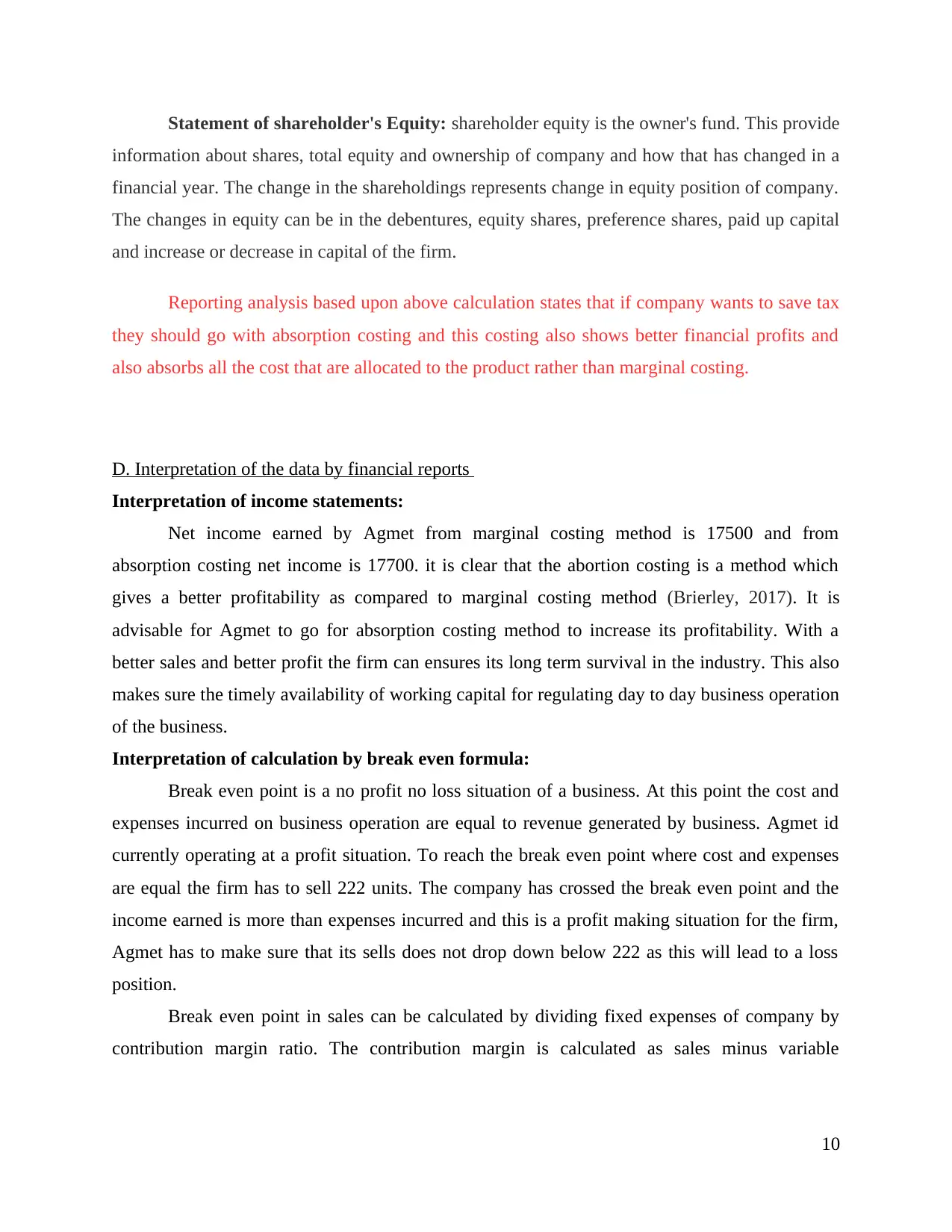
information about shares, total equity and ownership of company and how that has changed in a
financial year. The change in the shareholdings represents change in equity position of company.
The changes in equity can be in the debentures, equity shares, preference shares, paid up capital
and increase or decrease in capital of the firm.
Reporting analysis based upon above calculation states that if company wants to save tax
they should go with absorption costing and this costing also shows better financial profits and
also absorbs all the cost that are allocated to the product rather than marginal costing.
D. Interpretation of the data by financial reports
Interpretation of income statements:
Net income earned by Agmet from marginal costing method is 17500 and from
absorption costing net income is 17700. it is clear that the abortion costing is a method which
gives a better profitability as compared to marginal costing method (Brierley, 2017). It is
advisable for Agmet to go for absorption costing method to increase its profitability. With a
better sales and better profit the firm can ensures its long term survival in the industry. This also
makes sure the timely availability of working capital for regulating day to day business operation
of the business.
Interpretation of calculation by break even formula:
Break even point is a no profit no loss situation of a business. At this point the cost and
expenses incurred on business operation are equal to revenue generated by business. Agmet id
currently operating at a profit situation. To reach the break even point where cost and expenses
are equal the firm has to sell 222 units. The company has crossed the break even point and the
income earned is more than expenses incurred and this is a profit making situation for the firm,
Agmet has to make sure that its sells does not drop down below 222 as this will lead to a loss
position.
Break even point in sales can be calculated by dividing fixed expenses of company by
contribution margin ratio. The contribution margin is calculated as sales minus variable
10
⊘ This is a preview!⊘
Do you want full access?
Subscribe today to unlock all pages.

Trusted by 1+ million students worldwide
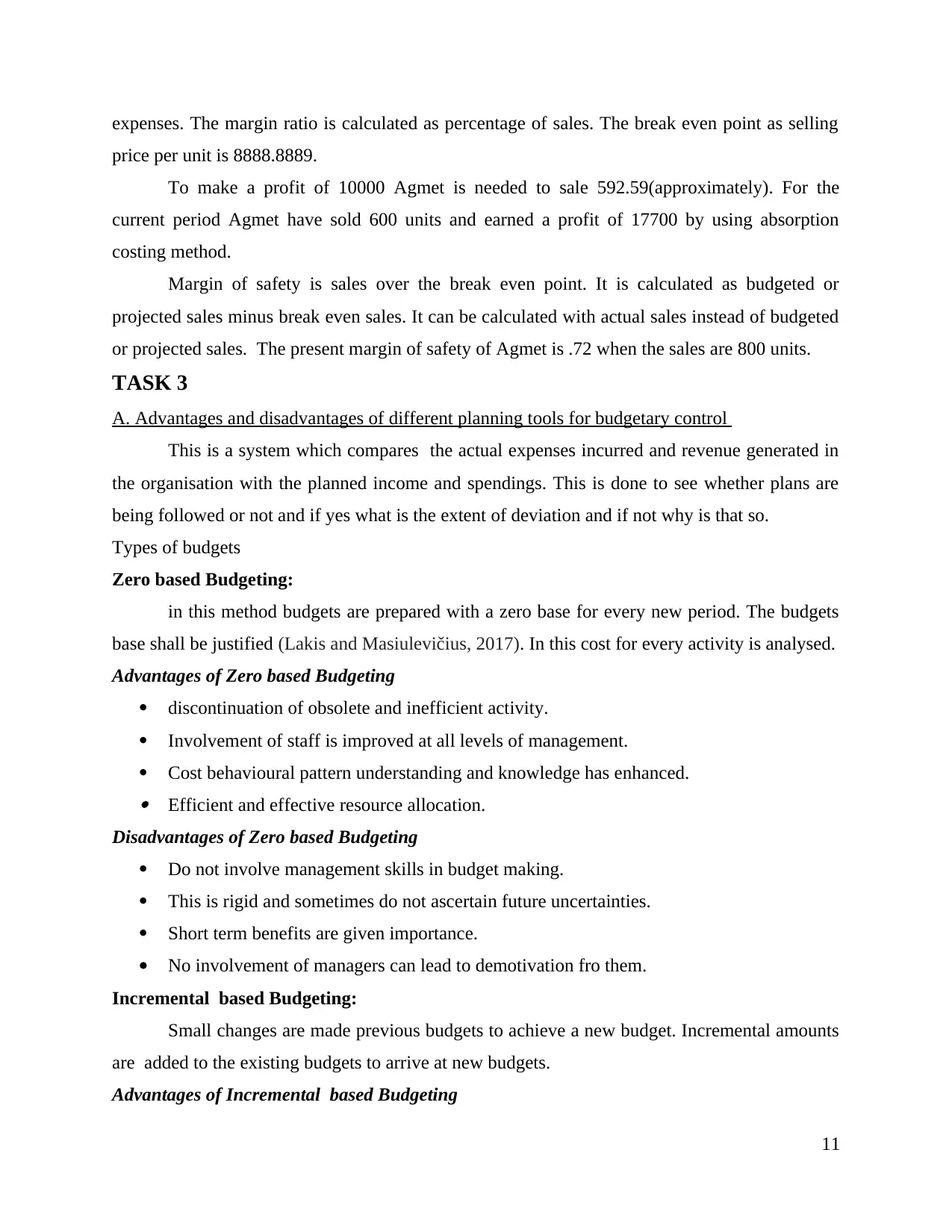
price per unit is 8888.8889.
To make a profit of 10000 Agmet is needed to sale 592.59(approximately). For the
current period Agmet have sold 600 units and earned a profit of 17700 by using absorption
costing method.
Margin of safety is sales over the break even point. It is calculated as budgeted or
projected sales minus break even sales. It can be calculated with actual sales instead of budgeted
or projected sales. The present margin of safety of Agmet is .72 when the sales are 800 units.
TASK 3
A. Advantages and disadvantages of different planning tools for budgetary control
This is a system which compares the actual expenses incurred and revenue generated in
the organisation with the planned income and spendings. This is done to see whether plans are
being followed or not and if yes what is the extent of deviation and if not why is that so.
Types of budgets
Zero based Budgeting:
in this method budgets are prepared with a zero base for every new period. The budgets
base shall be justified (Lakis and Masiulevičius, 2017). In this cost for every activity is analysed.
Advantages of Zero based Budgeting
discontinuation of obsolete and inefficient activity.
Involvement of staff is improved at all levels of management.
Cost behavioural pattern understanding and knowledge has enhanced. Efficient and effective resource allocation.
Disadvantages of Zero based Budgeting
Do not involve management skills in budget making.
This is rigid and sometimes do not ascertain future uncertainties.
Short term benefits are given importance.
No involvement of managers can lead to demotivation fro them.
Incremental based Budgeting:
Small changes are made previous budgets to achieve a new budget. Incremental amounts
are added to the existing budgets to arrive at new budgets.
Advantages of Incremental based Budgeting
11
Paraphrase This Document
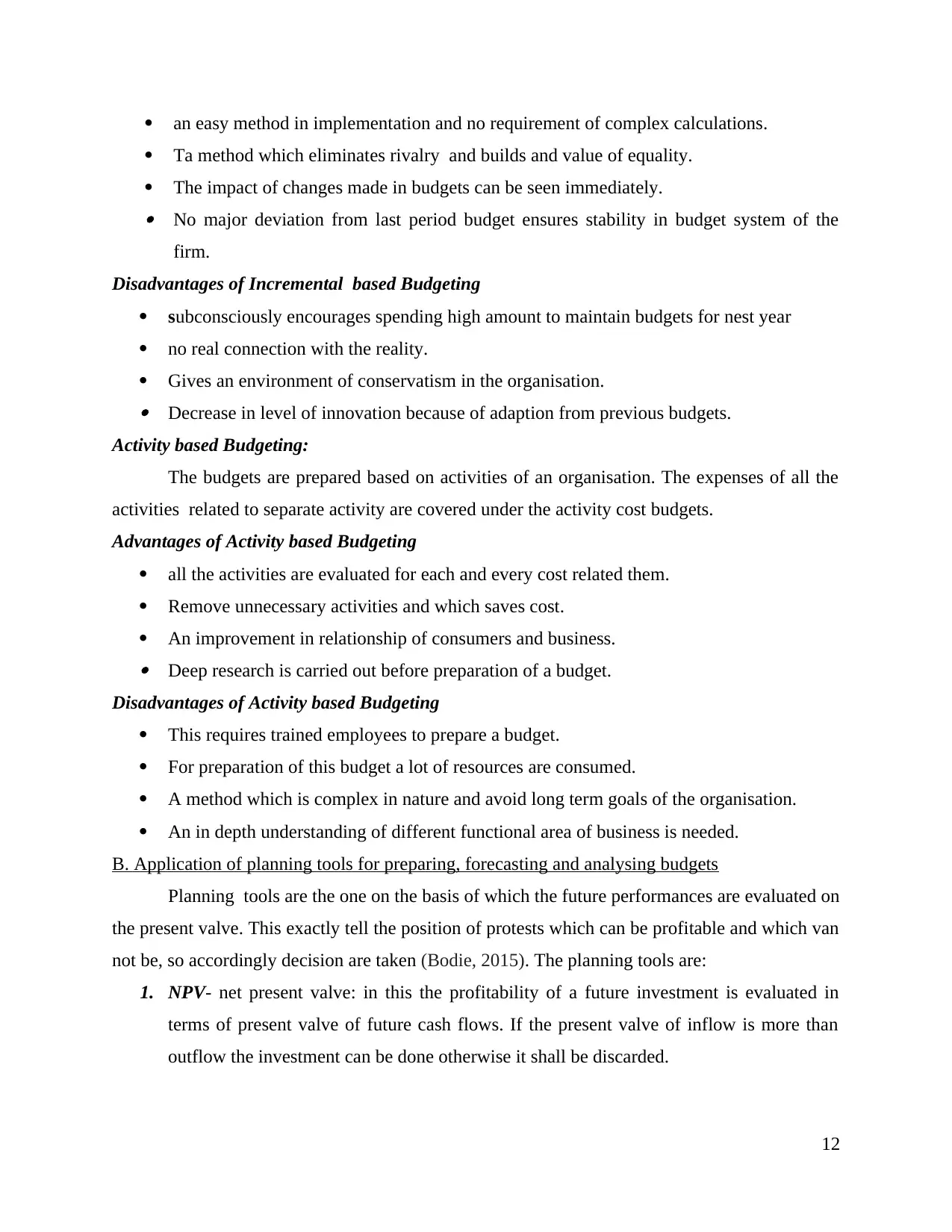
Ta method which eliminates rivalry and builds and value of equality.
The impact of changes made in budgets can be seen immediately. No major deviation from last period budget ensures stability in budget system of the
firm.
Disadvantages of Incremental based Budgeting
subconsciously encourages spending high amount to maintain budgets for nest year
no real connection with the reality.
Gives an environment of conservatism in the organisation. Decrease in level of innovation because of adaption from previous budgets.
Activity based Budgeting:
The budgets are prepared based on activities of an organisation. The expenses of all the
activities related to separate activity are covered under the activity cost budgets.
Advantages of Activity based Budgeting
all the activities are evaluated for each and every cost related them.
Remove unnecessary activities and which saves cost.
An improvement in relationship of consumers and business. Deep research is carried out before preparation of a budget.
Disadvantages of Activity based Budgeting
This requires trained employees to prepare a budget.
For preparation of this budget a lot of resources are consumed.
A method which is complex in nature and avoid long term goals of the organisation.
An in depth understanding of different functional area of business is needed.
B. Application of planning tools for preparing, forecasting and analysing budgets
Planning tools are the one on the basis of which the future performances are evaluated on
the present valve. This exactly tell the position of protests which can be profitable and which van
not be, so accordingly decision are taken (Bodie, 2015). The planning tools are:
1. NPV- net present valve: in this the profitability of a future investment is evaluated in
terms of present valve of future cash flows. If the present valve of inflow is more than
outflow the investment can be done otherwise it shall be discarded.
12
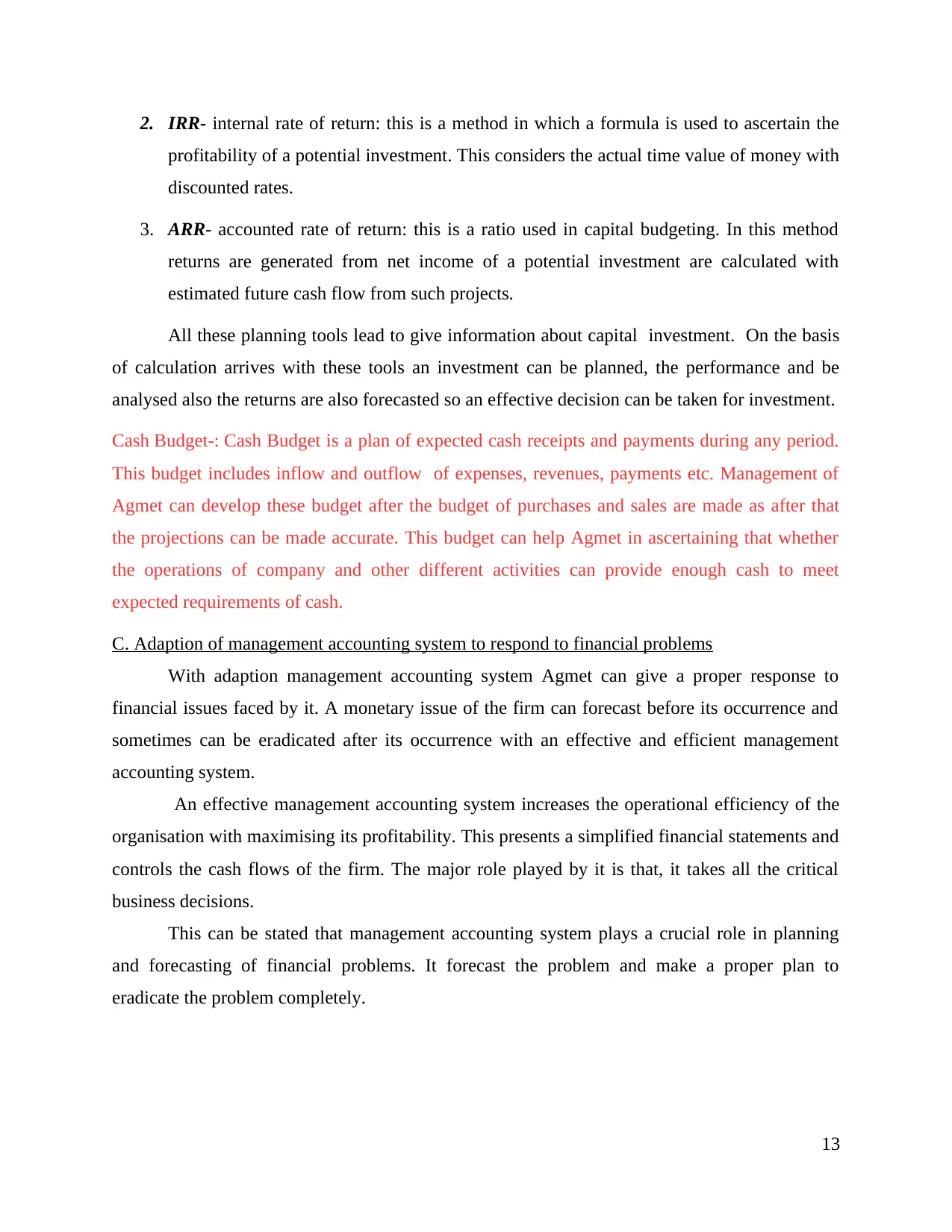
profitability of a potential investment. This considers the actual time value of money with
discounted rates.
3. ARR- accounted rate of return: this is a ratio used in capital budgeting. In this method
returns are generated from net income of a potential investment are calculated with
estimated future cash flow from such projects.
All these planning tools lead to give information about capital investment. On the basis
of calculation arrives with these tools an investment can be planned, the performance and be
analysed also the returns are also forecasted so an effective decision can be taken for investment.
Cash Budget-: Cash Budget is a plan of expected cash receipts and payments during any period.
This budget includes inflow and outflow of expenses, revenues, payments etc. Management of
Agmet can develop these budget after the budget of purchases and sales are made as after that
the projections can be made accurate. This budget can help Agmet in ascertaining that whether
the operations of company and other different activities can provide enough cash to meet
expected requirements of cash.
C. Adaption of management accounting system to respond to financial problems
With adaption management accounting system Agmet can give a proper response to
financial issues faced by it. A monetary issue of the firm can forecast before its occurrence and
sometimes can be eradicated after its occurrence with an effective and efficient management
accounting system.
An effective management accounting system increases the operational efficiency of the
organisation with maximising its profitability. This presents a simplified financial statements and
controls the cash flows of the firm. The major role played by it is that, it takes all the critical
business decisions.
This can be stated that management accounting system plays a crucial role in planning
and forecasting of financial problems. It forecast the problem and make a proper plan to
eradicate the problem completely.
13
⊘ This is a preview!⊘
Do you want full access?
Subscribe today to unlock all pages.

Trusted by 1+ million students worldwide
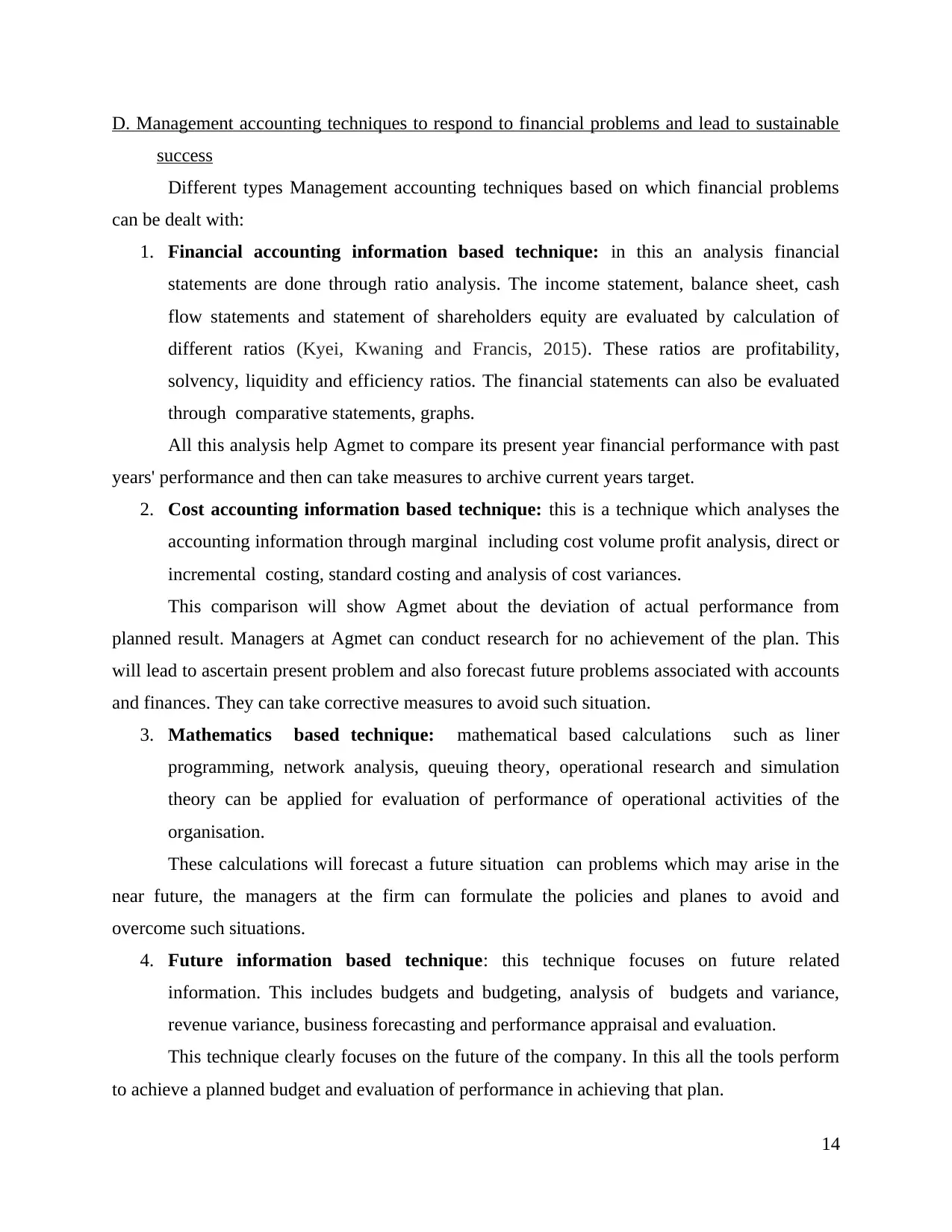
success
Different types Management accounting techniques based on which financial problems
can be dealt with:
1. Financial accounting information based technique: in this an analysis financial
statements are done through ratio analysis. The income statement, balance sheet, cash
flow statements and statement of shareholders equity are evaluated by calculation of
different ratios (Kyei, Kwaning and Francis, 2015). These ratios are profitability,
solvency, liquidity and efficiency ratios. The financial statements can also be evaluated
through comparative statements, graphs.
All this analysis help Agmet to compare its present year financial performance with past
years' performance and then can take measures to archive current years target.
2. Cost accounting information based technique: this is a technique which analyses the
accounting information through marginal including cost volume profit analysis, direct or
incremental costing, standard costing and analysis of cost variances.
This comparison will show Agmet about the deviation of actual performance from
planned result. Managers at Agmet can conduct research for no achievement of the plan. This
will lead to ascertain present problem and also forecast future problems associated with accounts
and finances. They can take corrective measures to avoid such situation.
3. Mathematics based technique: mathematical based calculations such as liner
programming, network analysis, queuing theory, operational research and simulation
theory can be applied for evaluation of performance of operational activities of the
organisation.
These calculations will forecast a future situation can problems which may arise in the
near future, the managers at the firm can formulate the policies and planes to avoid and
overcome such situations.
4. Future information based technique: this technique focuses on future related
information. This includes budgets and budgeting, analysis of budgets and variance,
revenue variance, business forecasting and performance appraisal and evaluation.
This technique clearly focuses on the future of the company. In this all the tools perform
to achieve a planned budget and evaluation of performance in achieving that plan.
14
Paraphrase This Document
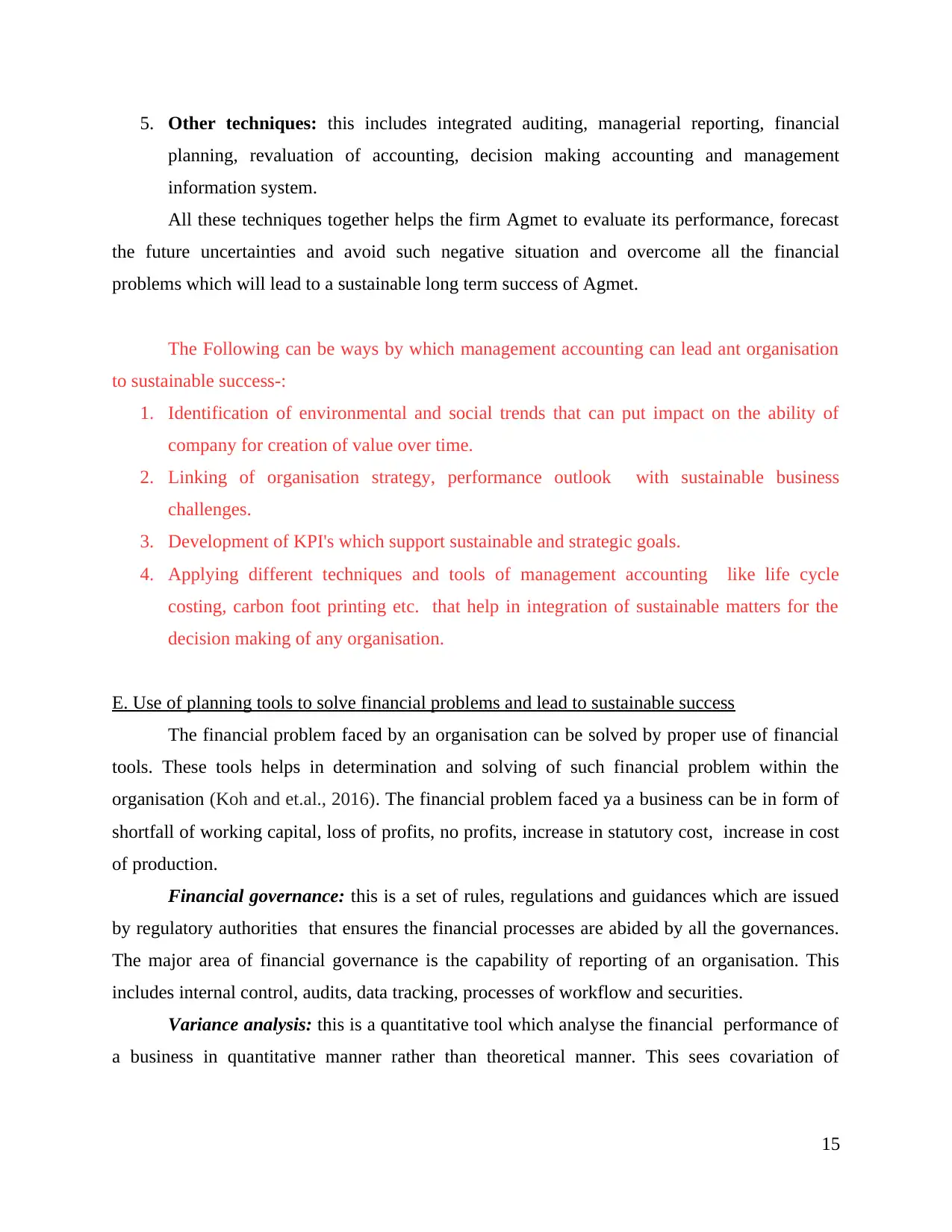
planning, revaluation of accounting, decision making accounting and management
information system.
All these techniques together helps the firm Agmet to evaluate its performance, forecast
the future uncertainties and avoid such negative situation and overcome all the financial
problems which will lead to a sustainable long term success of Agmet.
The Following can be ways by which management accounting can lead ant organisation
to sustainable success-:
1. Identification of environmental and social trends that can put impact on the ability of
company for creation of value over time.
2. Linking of organisation strategy, performance outlook with sustainable business
challenges.
3. Development of KPI's which support sustainable and strategic goals.
4. Applying different techniques and tools of management accounting like life cycle
costing, carbon foot printing etc. that help in integration of sustainable matters for the
decision making of any organisation.
E. Use of planning tools to solve financial problems and lead to sustainable success
The financial problem faced by an organisation can be solved by proper use of financial
tools. These tools helps in determination and solving of such financial problem within the
organisation (Koh and et.al., 2016). The financial problem faced ya a business can be in form of
shortfall of working capital, loss of profits, no profits, increase in statutory cost, increase in cost
of production.
Financial governance: this is a set of rules, regulations and guidances which are issued
by regulatory authorities that ensures the financial processes are abided by all the governances.
The major area of financial governance is the capability of reporting of an organisation. This
includes internal control, audits, data tracking, processes of workflow and securities.
Variance analysis: this is a quantitative tool which analyse the financial performance of
a business in quantitative manner rather than theoretical manner. This sees covariation of
15
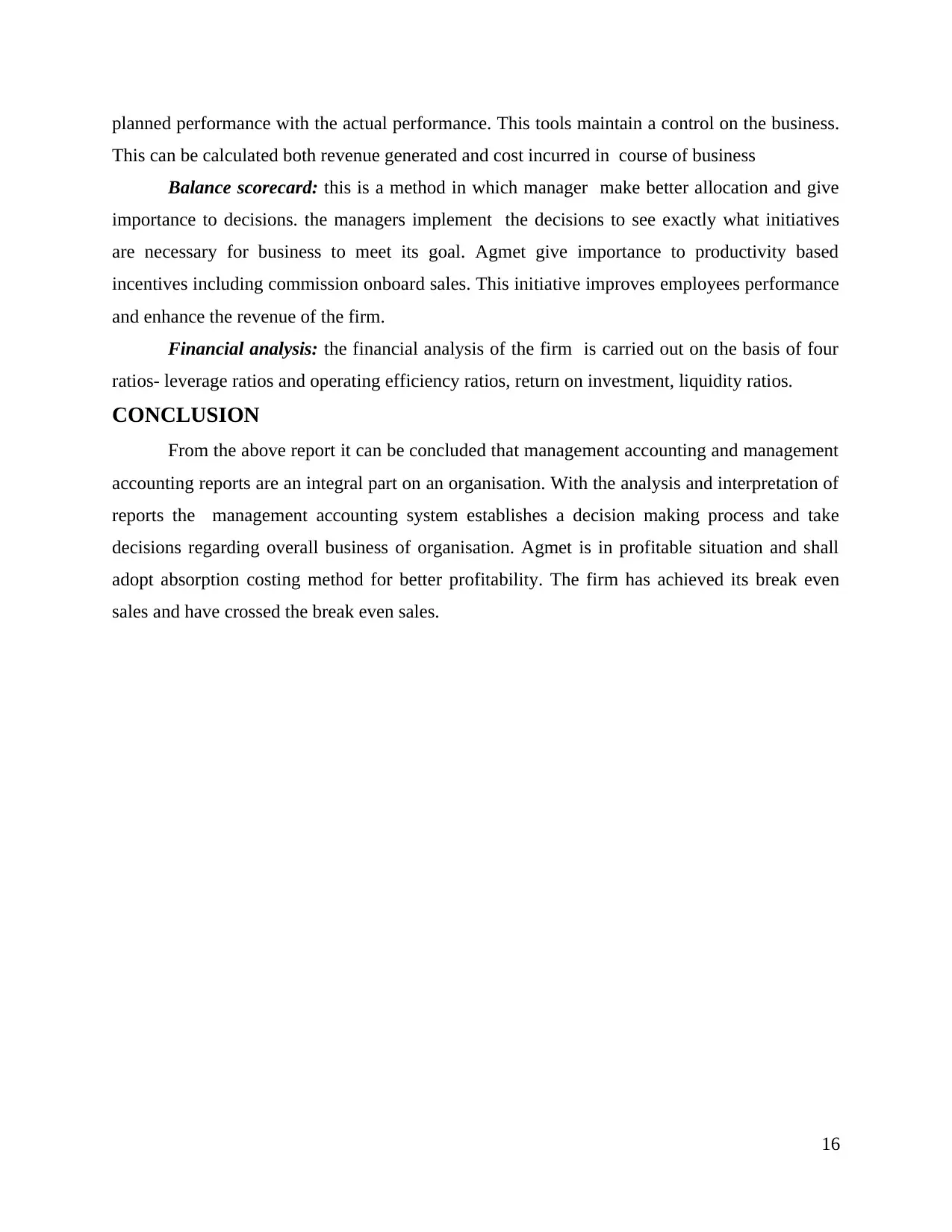
This can be calculated both revenue generated and cost incurred in course of business
Balance scorecard: this is a method in which manager make better allocation and give
importance to decisions. the managers implement the decisions to see exactly what initiatives
are necessary for business to meet its goal. Agmet give importance to productivity based
incentives including commission onboard sales. This initiative improves employees performance
and enhance the revenue of the firm.
Financial analysis: the financial analysis of the firm is carried out on the basis of four
ratios- leverage ratios and operating efficiency ratios, return on investment, liquidity ratios.
CONCLUSION
From the above report it can be concluded that management accounting and management
accounting reports are an integral part on an organisation. With the analysis and interpretation of
reports the management accounting system establishes a decision making process and take
decisions regarding overall business of organisation. Agmet is in profitable situation and shall
adopt absorption costing method for better profitability. The firm has achieved its break even
sales and have crossed the break even sales.
16
⊘ This is a preview!⊘
Do you want full access?
Subscribe today to unlock all pages.

Trusted by 1+ million students worldwide
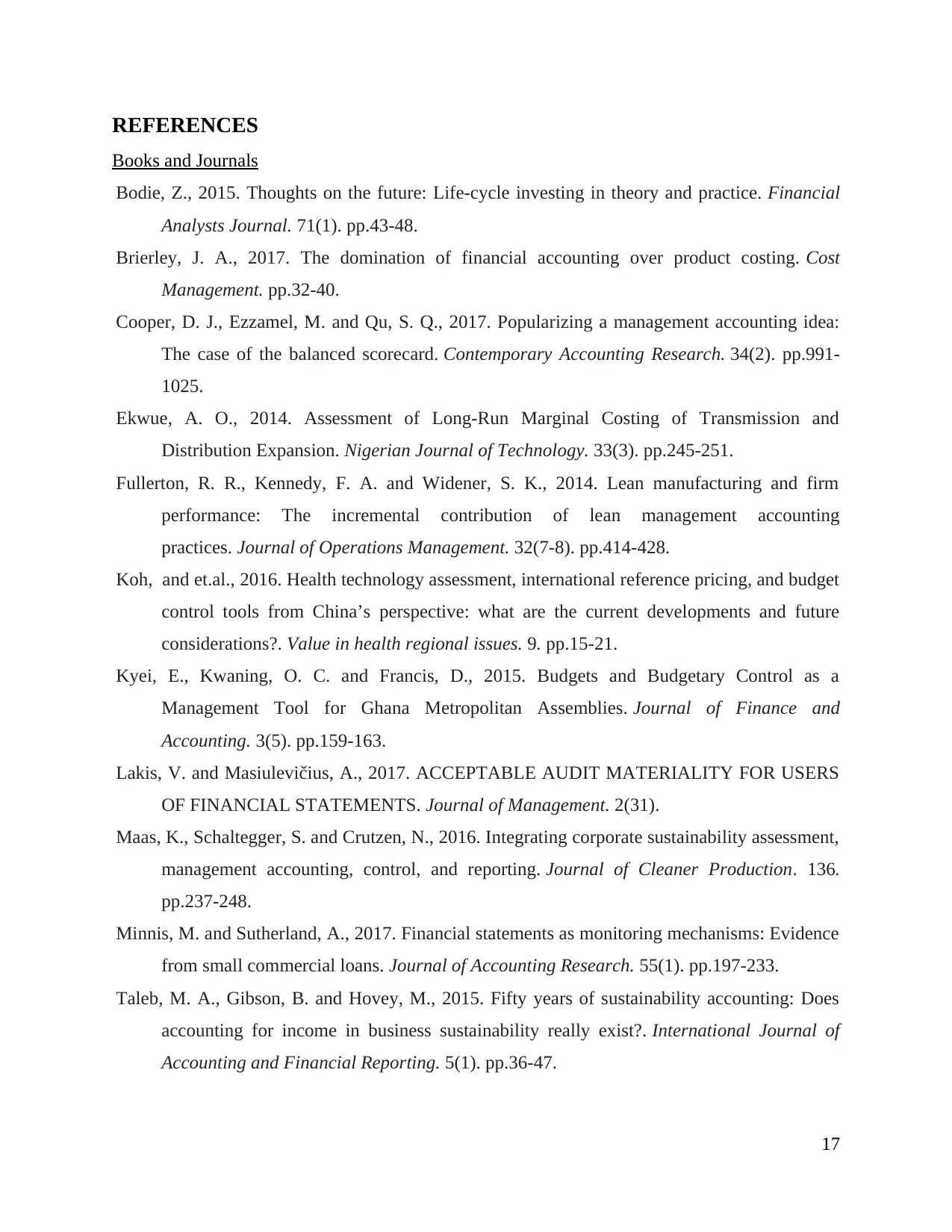
Books and Journals
Bodie, Z., 2015. Thoughts on the future: Life-cycle investing in theory and practice. Financial
Analysts Journal. 71(1). pp.43-48.
Brierley, J. A., 2017. The domination of financial accounting over product costing. Cost
Management. pp.32-40.
Cooper, D. J., Ezzamel, M. and Qu, S. Q., 2017. Popularizing a management accounting idea:
The case of the balanced scorecard. Contemporary Accounting Research. 34(2). pp.991-
1025.
Ekwue, A. O., 2014. Assessment of Long-Run Marginal Costing of Transmission and
Distribution Expansion. Nigerian Journal of Technology. 33(3). pp.245-251.
Fullerton, R. R., Kennedy, F. A. and Widener, S. K., 2014. Lean manufacturing and firm
performance: The incremental contribution of lean management accounting
practices. Journal of Operations Management. 32(7-8). pp.414-428.
Koh, and et.al., 2016. Health technology assessment, international reference pricing, and budget
control tools from China’s perspective: what are the current developments and future
considerations?. Value in health regional issues. 9. pp.15-21.
Kyei, E., Kwaning, O. C. and Francis, D., 2015. Budgets and Budgetary Control as a
Management Tool for Ghana Metropolitan Assemblies. Journal of Finance and
Accounting. 3(5). pp.159-163.
Lakis, V. and Masiulevičius, A., 2017. ACCEPTABLE AUDIT MATERIALITY FOR USERS
OF FINANCIAL STATEMENTS. Journal of Management. 2(31).
Maas, K., Schaltegger, S. and Crutzen, N., 2016. Integrating corporate sustainability assessment,
management accounting, control, and reporting. Journal of Cleaner Production. 136.
pp.237-248.
Minnis, M. and Sutherland, A., 2017. Financial statements as monitoring mechanisms: Evidence
from small commercial loans. Journal of Accounting Research. 55(1). pp.197-233.
Taleb, M. A., Gibson, B. and Hovey, M., 2015. Fifty years of sustainability accounting: Does
accounting for income in business sustainability really exist?. International Journal of
Accounting and Financial Reporting. 5(1). pp.36-47.
17
Related Documents
Your All-in-One AI-Powered Toolkit for Academic Success.
+13062052269
info@desklib.com
Available 24*7 on WhatsApp / Email
![[object Object]](/_next/static/media/star-bottom.7253800d.svg)
© 2024 | Zucol Services PVT LTD | All rights reserved.





